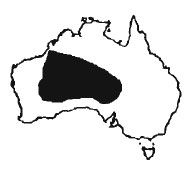Varanus Gilleni
 |
Gillen's goanna, Mulga monitor.
Gillen's goanna is found throughout the arid interior of Australia: in Western Australia, Northern Territory, Queensland and South Australia. As its common narne implies it is often found in areas of dense mulga (Acacia) but also inhabits more open deserts of spinifex and Eucalyptus (Cogger 1962; Thompson & Hosmer 1963; Pianka 1969; Delean 1980). It normally reaches a length of about 40cm (18cm SVL) but Green and King (1993) give its total length as 70cm. Mean weight of 4 examined by Bickler & Anderson (1986) was 30g. Bustard (1970) reports that tail is somewhat prehensile and may be used to grip branches whilst descending.
The mulga monitor shelters in trees but catches a lot of its food on the ground . It probably has the most diverse diet of any of the dwarf desert goannas. Spiders, orthopterans, beetles and other lizards are its usual prey, but they also eat larger items such as birds eggs and small mammals as well as animals the size of an ant. In captivity they will also accept fish (Pianka 1969; Barnett 1981; Losos & Greene 1988; James, Losos & king 1992). Like other dwarf goannas the mulga monitor often eats the tails of geckoes that it is unable to catch and/or swallow. They are usually found under bark or in tree hollows. Little is known of its behaviour in the wild but its diet indicates that it forages for food and investigates the daytime retreats of a number of terrestrial and arboreal geckoes. Active body temperatures of 36.4-:38.4°C have been recorded. Associations of large numbers of mulga monitors have been found together but it is uncertain whether they always live together or congregate for the breeding season (Greer 1989). In many areas they are uncommon. Females may contain eggs at any time except the late summer and early winter and may lay more than one clutch per year. Clutches of up to seven eggs have been reported which. in captivity at least, hatch after about 3 months. Eggs may be laid at the end of a 30cm deep burrow. and the entrance may be sealed with sand (Pianka 1969; James. Losos & King 1992; Schmida 1985). Ritual fighting has been described several times, and even occurs between juveniles (Murphy & Mitchell 1974; Carpenter et al 1976; Hom 1985). The animals lie belly to belly, embracing each other at the shoulders and the pelvis and attempt to flip each other over. Bickler & Anderson (1986) studied the rate of oxygen consumption in V.gilleni and found that they were unable to exhaust specimens on treadmills running at 1km per hour. Even after "many minutes" they were able to run without building up any oxygen debt. At rest they use just .2ml of oxygen per gramme per hour, this figure rises almost 30 fold during energetic exercise. Rates of water loss in Gillen's goanna is half that of other Australian varanids studied (0.06mg of water per cm2 of skin per hour at 30°c) (Green & King 1993).
The mulga monitor has reproduced in captivity on at least several occasions (Horn 1978; Gow 1982; Boyle & Lamoreaux 1983; Broer & Horn 1985; Eidenmuller 1994. Husband. pers.comm.). The animals can be sexed by the presence of spines on either side of the vent in males. An enclosure with a floor area of 1m2 is sufficient to house a pair. It should be furnished in the manner typical for desert monitors with plenty of branches and shelters above the ground. Temperature and photoperiod should fluctuate seasonally and diet should reflect the variety of animals taken in the wild. Ambient temperatures of 20-30°C (16-24°C during winter) are suitable. Eggs incubated between 27-30°C hatch after 89-104 days. Hatchlings weigh 2-3g and measure 12-14cm (5-6cm SVL).
Attribution / Courtesy: Daniel Bennett. 1995. A Little Book of Monitor Lizards. Viper Press U.K.




